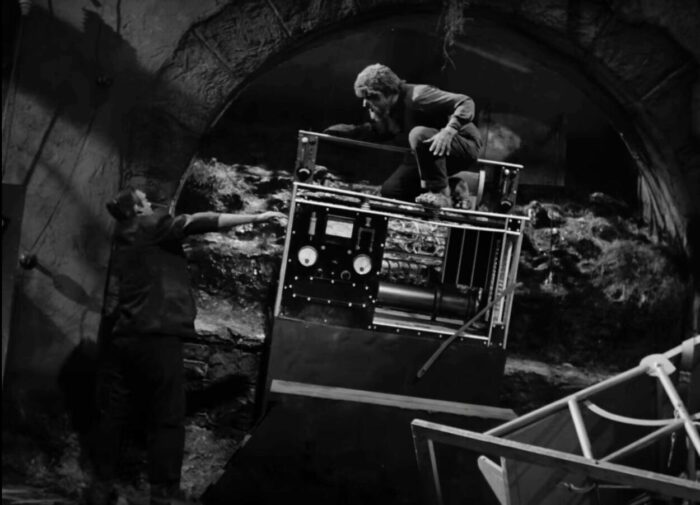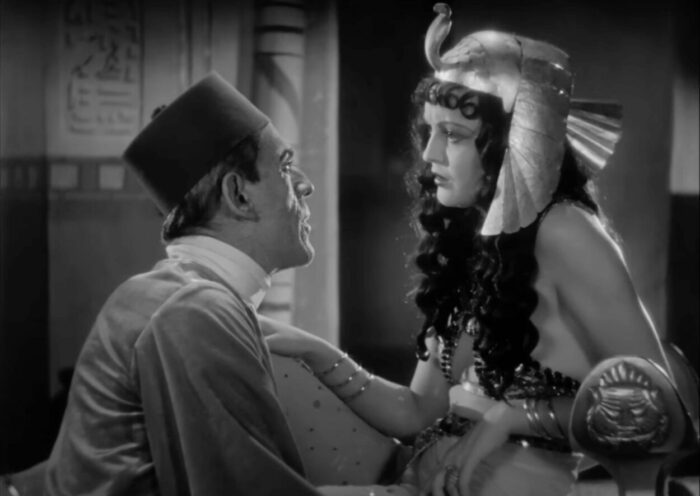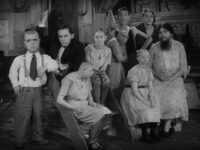October is horror-movie month, and there has never been a better time to watch the classic horror movies of Universal Pictures, the Hollywood studio most identified with the genre. Universal horror is currently streaming on NBCUniversal’s Peacock and a Universal Monsters channel has landed on Amazon’s ad-supported streaming service Freevee, available to Amazon Prime subscribers using the Prime Video smart TV app. But where to begin for the uninitiated? Are there movies outside the canon worth seeing? Scream 2 taught us that “sequels suck,” but is that true of all sequels? Fear not, children of the night. This ranked listicle in two parts will prepare you for your journey up the Borgo Pass and beyond.
6. The Gill-Man Trilogy
Creature from the Black Lagoon (Jack Arnold, 1954), Revenge of the Creature (Jack Arnold, 1955), The Creature Walks Among Us (John Sherwood, 1956)

In 1946, Universal merged with International Pictures and put a moratorium on the supernatural horror films in which it had specialized over the previous 15 years. By the mid-1950s, however, the studio resumed its production of monster movies in the idiom of science fiction, thanks largely to producer William Alland and director Jack Arnold. Sci-fi movies were among the latest Atomic Age crazes, and of the nine sci-fi monster movies Alland produced for Universal, Arnold directed four, including Creature from the Black Lagoon and Revenge of the Creature (the authors of Universal Terrors, 1951-1955 dispute Arnold’s claim that he was the uncredited director of scenes on planet Metaluna in This Island Earth [1955]).
The “Creature,” christened the Gill-Man, is the only monster from this period to return to the screen in sequels. Capitalizing on another midcentury fad, the first two films in the trilogy were shot and originally exhibited in 3D. As the first film tells us, the Gill-Man is a descendent of the Devonian age and has survived in the upper Amazon, possibly evidencing a missing link between marine and land animals. Creature from the Black Lagoon and Revenge of the Creature, respectively, focus on his discovery in South America and captivity in a Florida Oceanarium. Also produced by Alland, but directed by John Sherwood, The Creature Walks Among Us concerns his mutation into human form after an unethical scientist takes him out of aquatic surroundings. The Gill-Man has been alternately celebrated and mocked (sometimes both at once) for the kitsch value of seeing bathing beauty Julie Adams (credited as Julia Adams) abducted by a guy in a rubber fish-suit. Don’t let the ‘50s nostalgia fool you: these films have a sincere environmental conscience and ultimately side with the Gill-Man over the “monstrous” humans.
Horror-trivia note: Bud Westmore received the makeup credit for Creature from the Black Lagoon and claimed to have been responsible for the Gill-Man design, but since then researchers such as Mallory O’Meara have uncovered that animator, actress, and makeup artist Milicent Patrick designed the Gill-Man costume without proper recognition. For the dreamy, almost poetic shots of the Gill-Man underwater, Ricou Browning donned the suit on location in Wakulla Springs, Florida, while Ben Chapman wore it to play the Gill-Man on land at Universal. Recently deceased, Browning was the last surviving performer to portray a classic Universal monster.
7. Frankenstein Meets the Wolf Man (Roy William Neill, 1943)

When the Regina-Wilshire Theatre in Los Angeles hit paydirt in 1938 by programming Dracula (1931), Frankenstein (1931), and RKO’s Son of Kong (1933) on a triple bill, Universal decided to revive its monster-properties by rolling out sequels like Son of Frankenstein (1939), introducing a new werewolf (Larry Talbot) and mummy (Kharis), and bringing together multiple monsters in the same movie with a series of “monster rallies.” Produced by George Waggner, the producer-director of The Wolf Man (1941), with a screenplay by Wolf Man scribe Curt Siodmak, Frankenstein Meets the Wolf Man serves as a sequel to both The Wolf Man and The Ghost of Frankenstein (1942) by converging the two storylines (while also playing fast-and-loose with continuity). Chaney reprises his role as the cursed, undying Larry Talbot, and this time Bela Lugosi plays the Frankenstein Monster. Without a shred of irony or hyperbole, I can assure you that Frankenstein Meets the Wolf Man is an inordinately good-looking film (a sentence I am as surprised to write as you may be to read).
As the title suggests, this first monster rally represents Universal horror at its most juvenile and contrived, but for all of its silliness, it’s also one of the studio’s most purely enjoyable films, the equivalent of a bag of Halloween candy without the stomachache. Ilona Massey co-stars as the daughter of the first Dr. Frankenstein, whom Larry tracks down in the hopes of learning how he might end his life, and Patric Knowles plays Larry’s doctor, who falls under the spell of Frankenstein’s notes on reanimating the dead. Lugosi is all wrong for the Frankenstein Monster, but it’s possible to overlook the miscasting if one bears in mind that at the end of The Ghost of Frankenstein, Ygor (also played by Lugosi) had has brain transplanted into the Monster (then played by Chaney!). Continuing the crossover storyline of Frankenstein Meets the Wolf Man, albeit with much less entertaining results, Universal followed it with House of Frankenstein (1944) and House of Dracula (1945) (by that point, the studio added John Carradine into the mix as Dracula and recast the part of the Frankenstein Monster with Glenn Strange). Universal also reunited the Frankenstein Monster, the Wolf Man, and Dracula in Abbott and Costello Meet Frankenstein (1948)—Strange and Chaney starred alongside Lugosi, finally back as the Count—and in the abysmal Van Helsing (2004).
Horror-trivia note: Assuming that if audiences heard the Monster speak in Lugosi’s thick Hungarian accent, they would either find him unintendedly funny or altogether unintelligible, Universal wisely cut Lugosi’s dialogue scenes in Frankenstein Meets the Wolf Man, which would have reminded audiences that the Monster lost his eyesight in the brain transplant. As a result, Lugosi’s stiff, robotic gait—arms outstretched, groping blindly—was left unexplained in the film, but became the unmistakable “Frankenstein-Monster walk” we now identify with the character. Ironically, Lugosi claimed to have turned down the part of the Monster in the original Frankenstein (1931) before it went to Boris Karloff.
8. Dracula (Tod Browning, 1931) / Dracula (George Melford, 1931)

The same caveat for Universal’s Frankenstein (1931) applies to the studio’s version of Dracula: abandon hope all ye who enter here seeking a faithful adaptation of the literary source. Bram Stoker’s Victorian novel Dracula had been adapted for the stage by British producer and playwright Hamilton Deane, who updated the setting to the 1920s, and the play debuted in England in 1924. John L. Balderston revised it for Broadway, where it ran from 1927 to 1928. After Universal acquired the rights, Dudley Murphy submitted a script that the studio then turned over to Garrett Fort for the final pass (only Fort received screen credit), and Broadway cast members Bela Lugosi and Edward Van Sloan reprised their roles as Count Dracula and Professor Van Helsing, respectively. The film opened in the U.S. on February 12, 1931, nine months before Frankenstein, kicking off Universal’s horror trend in the 1930s and introducing one of its most durable characters (look no further than this year’s Renfield and The Last Voyage of the Demeter for evidence of the studio’s lasting investment in this property).
Like Frankenstein, Dracula owes more to the play than the novel, but unlike James Whale’s dark phantasmagoria, Tod Browning’s film feels confined to rather stodgy conversations that occur in plain interior spaces—a frustrating tendency after the exquisitely beautiful first half. Still, the film is a must-see for Lugosi’s weird, mannered performance, and for Dwight Frye as Dracula’s histrionic familiar Renfield. In many ways, the Spanish-language version that George Meloford directed for Universal simultaneously is a superior film. Reputed for its greater degree of sensuality than Browning’s version, it also feels like a more complete film, running practically a half an hour longer. What it lacks in Lugosi and Frye, it makes up for in the presence of Mexican actress Lupita Tovar, whose Eva is a far more compelling heroine than Helen Chandler’s insipid Mina.
Horror-trivia note: The “Spanish Dracula,” as it’s often called, is an example of the short-lived practice of multi-lingual film productions, an attempt on the part of the Hollywood studios to expand beyond an exclusively English-language market after the conversion to sound. A film would be restaged and reshot in different languages with a different cast, using the same sets as the English-language version. George Melford relied on the aid of an interpreter to direct the Spanish-speaking cast of his Dracula, arriving on the Universal lot after Browning’s cast and crew left work each night. Talk about vampiric!
9. Son of Dracula (Robert Siodmak, 1943)

Never mind what the title says: Lon Chaney Jr. is playing Dracula himself, not his son, although he is posing as a European Count named Alucard (“Dracula” spelled backwards). The film is an alternate-continuity sequel to Tod Browning’s 1931 Dracula, following the in-continuity sequel Dracula’s Daughter (1936), and it even acknowledges the character’s mythic status from literature and folklore. We actually see a character reading Dracula at one point! The feature monster also isn’t really Dracula, but his bride Katherine, played by Louise Allbritton (all for the best since the awkwardly fitting Chaney seems to have been cast solely for his own exploitable profile as the son of a legendary monster-movie star).
Semantics aside, Son of Dracula is as moody and atmospheric as any horror film you’re likely to see from the 1940s, a testament to director Robert Siodmak’s keen sense of visual style. Siodmak went on to direct many of Universal’s entries in what is now called film noir—Phantom Lady (1944), Christmas Holiday (1944), The Suspect (1944), The Strange Affair of Uncle Harry (1945), The Killers (1946), The Dark Mirror (1946), and Criss Cross (1949)—and indeed Son of Dracula qualifies as some kind of noir outlier. In the fatalistic tradition of noir, Son of Dracula arrives at an inevitably tragic conclusion, and in that way fills a gap in Universal’s Dracula series with a doomed romance worthy of vampires. If the director’s surname has a familiar ring, recall that Curt Siodmak (Robert’s brother) was a writer for Universal. After Curt wrote the film’s treatment, Robert expelled him from the production out of a life-long sibling rivalry and the script was written by Eric Taylor.
Horror-trivia note: It’s hard to imagine a vampire without visible fangs, but neither Chaney nor Lugosi wear the set of extra-pointy canines that are now part and parcel of your standard vampire-makeup kit (for that matter, neither did Carlos Villarías in the Spanish Dracula [1931] nor did Gloria Holden in Dracula’s Daughter). Credit goes to Christopher Lee for popularizing the Count’s bloody, befanged look, as he played a more violent and physically active Dracula in a series of films for Britain’s Hammer Film Productions between 1958 and 1973. (Whispers: Lee is my favorite Dracula.)
10. The Mummy (Karl Freund, 1932)

Admittedly, The Mummy shows its age more than any other film on this list, but patient viewers will be rewarded with a star-crossed love story that’s a lot more satisfying than the relentless, CGI-driven action of Universal’s remake, The Mummy (1999), or its sequel, The Mummy Returns (2001). Boris Karloff plays Imhotep, an Ancient Egyptian high-priest who was subjected to live mummification as punishment for stealing a sacred scroll in an attempt to resurrect the deceased Anck-es-en-Amon, the princess with whom he had been engaging in a clandestine affair. When he is accidentally brought back to life by archeologists on an expedition for the British Museum, he takes the form of a parched Egyptian gentleman calling himself Ardath Bey and discovers that Anck-es-en-Amon has been reincarnated in a woman named Helen Grosvenor (Zita Johann), Egyptian on her mother’s side, who longs for Ancient Egypt for reasons she doesn’t yet fully comprehend.
Director Karl Freund had worked on Dracula (1931) as the cinematographer, and The Mummy reunited Dracula stars Edward Van Sloan and David Manners, more or less reprising their roles as Van Helsing and John Harker, respectively. John L. Balderston, who revised the stage versions of Dracula and Frankenstein for Broadway, wrote the script for The Mummy based on Nina Wilcox Putnam and Richard Schayer’s treatment. In contra distinction from Dracula and Frankenstein, there was no literary source for The Mummy, but the film still had a built-in audience. The opening of King Tutankhamun’s tomb had sparked a fascination with Egyptology that swept the West over the previous ten years.
Horror-trivia note: Karloff’s Imhotep is not the wrapped-in-bandages mummy dragging one foot behind him when he walks. This familiar image actually originated in The Mummy’s Hand (1940) with Tom Tyler, a vastly inferior film that Universal produced telling a new story about a different mummy named Kharis. The Mummy’s Hand generated three mediocre sequels with Lon Chaney Jr. In The Mummy from 1932, we catch something only slightly more than a glimpse of the completely bandaged Karloff. That’s not a dig at Jack Pierce’s incredible Ardath Bey makeup, but rather a curious observation about a false collective memory.
Works Consulted
Behlmer, Rudy. Behind the Scenes: The Making Of…. Samuel French, 1990.
Berenstein, Rhona J. Attack of the Leading Ladies: Gender, Sexuality, and Spectatorship in Classic Horror Cinema. Columbia UP, 1996.
Phillips, Kendall. A Place of Darkness: The Rhetoric of Horror in Early American Cinema. U of Texas P, 2018.
Weaver, Tom, Michael Brunas, and John Brunas. Universal Horrors: The Studio’s Classic Films, 1931 – 1946. 2nd ed., McFarland, 2007.
Weaver, Tom, et al. Universal Terrors, 1951 – 1955: Eight Classic Horror and Sci-Fi Films. McFarland, 2017.



